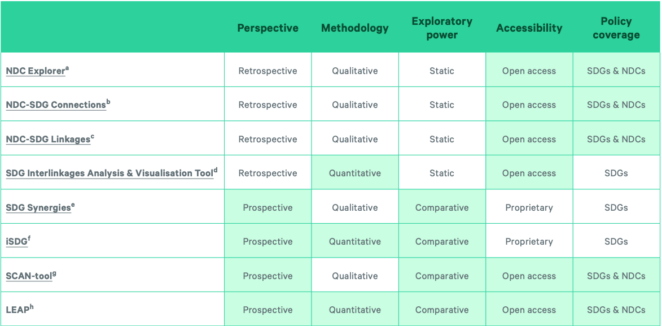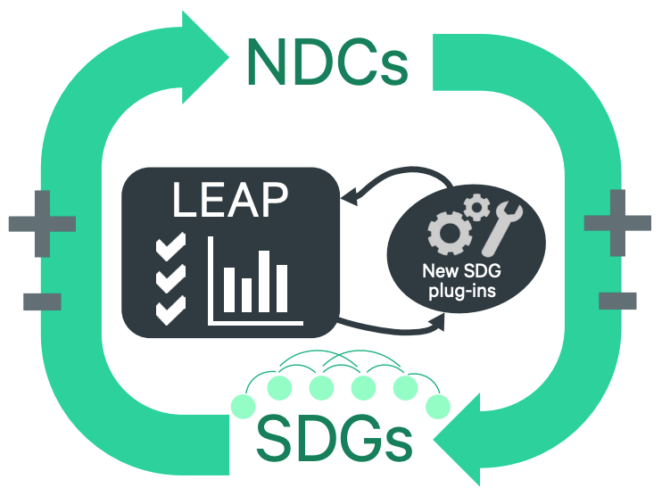Overcoming Barriers to Integrated Planning: Tools and Training for Countries to Combine Climate and Development Aims

This brief is an output of the SEI Initiative on Integrated Climate and Development Planning, which leverages technological and methodological advances and strategic approaches to reach both climate and development aims. The initiative builds and reinforces capacity of in-country planners to achieve their goals, and to enhance their ambitions.
This text has been reproduced from a SEI discussion brief. Please see the full text for details of references.
This article should be cited as Wagner, C.C., Veysey, J., Nolan, S.T., & Malley, C. (2022). Overcoming barriers to integrated planning – tools and training for countries to combine climate and development aims. SEI discussion brief. https://doi.org/10.51414/sei2022.023
Key messages
- The goals of the Paris Agreement and the 2030 Agenda for Sustainable Development tightly interlink across social, technical and economic spheres. Achieving them requires swift and vigorous action by policymakers now.
- An integrated approach to climate and development policy planning is essential to capitalize on synergies among goals and to avoid achieving some goals at the expense of others.
- Such integrated planning requires accessible, quantitative tools that can compare policy options, and analyse impacts on Sustainable Development Goals (SDGs) and climate mitigation.
- This brief outlines recent improvements to SEI’s pioneering Low Emissions Analysis Platform (LEAP), which, to the best of our knowledge, is the lone available tool that meets these criteria.
- The brief also highlights SEI’s work to advance integrated planning through a dedicated initiative to expand the LEAP tool’s capabilities and to train planners in low and middle-income countries to build their in-country capacity.
Introduction
The United Nations’ 17 Sustainable Development Goals (SDGs) are integrated and indivisible, meaning that none of the goals should be attained at the expense of another (UN General Assembly, 2015). This principle encompasses climate change mitigation, as this is an objective of SDG 13. It is likewise reflected in the Paris Agreement, which characterizes actions to limit global warming to 2°C or even 1.5°C as an integral part of achieving a better, more sustainable future (Adoption of the Paris Agreement, 2015). However, despite this basic recognition of the relationship between climate change mitigation and sustainable development, the implementation of the Paris Agreement through countries’ national climate mitigation plans, known as Nationally Determined Contributions (NDCs), has only sporadically accounted for connections to SDGs (UNFCCC Secretariat, 2021).
The ambition of these two agendas requires swift and decisive action by policy-makers, but interlinkages between the development goals, including climate action, means that aggressively pursuing any one will likely affect related development priorities (McGowan et al., 2019). This is an important consideration for planning. First, not all pathways towards achieving a 1.5°C target will advance SDGs equally; indeed, some paths may negatively impact other development goals. Second, policy-makers have limited resources; this means that optimizing potential climate and development synergies is vital.
The urgency of climate action has only grown since the IPCC’s 1.5°C and 6th Assessment reports: These studies present unequivocal evidence that humans are causing a significant increase in atmospheric greenhouse gas concentrations, with present-day average global warming already amounting to 1.1°C and hot extremes and heavy precipitation events becoming more frequent (IPCC, 2018, 2021). While robust positive synergies between health (SDG 3), energy (SDG 7), responsible consumption and production (SDG 12), oceans (SDG 14) and climate mitigation action are expected, the special IPCC report on the impacts of Global Warming of 1.5°C identified substantial risks of trade-offs or negative side effects between the stringent mitigation action required in the next decade to limit warming to 1.5°C and SDGs 1 (poverty), 2 (hunger), 6 (water) and 7 (energy) (Roy et al., 2018).
These conclusions underscore the importance of integrated planning approaches that can identify synergies between SDGs and respond to the ambition required by a 1.5°C climate mitigation target. Ultimately, policy coherence between Agenda 2030 and the Paris Agreement is required to achieve these two global imperatives (Janetschek et al., 2020; WRI for UN DESA, 2019).
Analysis of available tools for integrated planning
Several software tools have emerged that assess interlinkages between various SDGs and, in some cases, between SDGs and NDCs. We examined existing tools to assess what is available to planners seeking to identify policies that maximize synergies between sustainable development and climate and compared them to LEAP, the Low Emissions Analysis Platform (LEAP), which has recently been expanded with new analysis capabilities to address a more extensive set of SDGs. We identified existing tools through a web search with the keywords “SDG, connections”, “SDG, NDC, connections”, “SDG, NDC, linkages”, and “SDG, NDC, synergies”. To be included, tools had to be universally applicable, rather than for a single country, region or sector. We evaluated the resulting eight tools along five key dimensions (see Table 1):
- Perspective: Does the tool consider historical data and policies only (retrospective), or can it analyze potential future policies and scenarios (prospective)? As a practical matter, tools that provide information about current policies are of limited use in evaluating new policies and deciding between potential future actions. Planners need tools that can help them judge the effectiveness of potential climate change mitigation actions in advancing SDGs. This is an essential need, particularly as mitigation ambition rises.
- Methodology: Is the tool qualitative or quantitative? Though qualitative assessments can be helpful in framing development choices, only quantitative tools can provide concrete information upon which decision-makers depend, including timing, costs, and deployment levels of climate mitigation and development interventions.
- Exploratory power: Can the tool be used to compare different sets of possible planning decisions (comparative), or are planning decisions taken as a given (static)?
- Accessibility: For most users, does the tool require paid access (proprietary), or is it freely available (open access)? Proprietary tools can offer useful functionality, but they are by their nature exclusionary, working against the broad social participation and acceptance needed for sustainability transitions. Proprietary tools may also be cost-prohibitive, particularly in low- and middle-income countries, and they limit the transparency and reproducibility of analyses.
- Policy coverage: Does the tool analyze both SDGs and NDCs? In view of calls for rapid action on climate change, effective planning tools must represent these connections. Fast-evolving climate plans may otherwise undermine sustainable development objectives.

Our analysis of the existing landscape shows that, to the best of our knowledge, only the Low Emissions Analysis Platform (LEAP) provides an open-access modelling tool that meets these requirements.1First developed in 1985 as a basic energy system modelling tool, LEAP has since been enhanced to enable policy makers to develop prospective policy scenarios assessing energy demand and supply, costs and benefits, emissions, and other types of externalities across the entire economy. LEAP has become a preferred option for countries performing greenhouse gas mitigation assessments and has already been used by more than 60 countries for their NDCs. Thus, increasing the SDG analysis capacity of LEAP presents an opportunity to further integrate SDGs into climate planning.
1LEAP is available free of charge to qualified academic, governmental, and nonprofit organizations based in low and middle-income countries and to students worldwide. Consulting companies, utilities and other businesses can access LEAP through a licensing arrangement. A read-only version of LEAP is also available at no cost to all users.
Helping planners integrate climate and development goals
SEI is undertaking work dedicated to advancing the integration of SDGs in NDCs and national climate plans. This effort, under the umbrella of the SEI Initiative on Integrated Climate and Development Planning, focuses on developing, enhancing, and applying methods that quantify the prospective impacts of climate change mitigation plans on SDGs. The Initiative seeks to enable policymakers to prioritize actions to increase synergies and minimize trade-offs between sustainable development and climate change mitigation, and concentrate efforts in areas that offer the greatest potential returns on resource investment.
The aims of the Initiative include a) advancing methods; b) developing SDG specific enhancements to LEAP and related tools; c) producing open-access models, and d) enhancing in-country planning capacity needed to achieve the two global goals.
Begun in 2019, the Initiative has developed four major extensions to LEAP that can be used to analyze impacts related to SDGs 3 (health), 8 (work and economic growth), and 9 (industry). They were selected to target areas determined to have the greatest potential risks and benefits from stringent climate mitigation action (Roy et al., 2018). A macroeconomic modelling extension (LEAP-Macro) can be used to assess impacts on employment, GDP growth, and other macroeconomic variables, while the LEAP Integrated Benefits Calculator permits quantifying links between climate change mitigation, air pollution, and human health. The AgHealth tool allows assessing links between agriculture, diet, human health and environmental impacts, and a forestry and other land-use (FOLU)-tool enables the assessment of greenhouse gas emissions from land use change. These extensions pair with LEAP’s native capabilities to model energy and emissions scenarios, which allow quantification of targets, indicators, and other metrics relevant to SDGs 7 (energy), 11 (cities and communities), 12 (consumption and production), and 13 (climate), among others. Crucially, the LEAP system supports modelling specific, granular measures that make up climate change mitigation strategies, such as the deployment of more efficient household cook stoves, the implementation of new vehicle efficiency and emission standards, and the development of rooftop solar. These features allow users to evaluate the feasibility of strategies and assess the impacts of particular measures on sustainable development priorities.

Responding to planning and policymaking needs
Over the past three decades, SEI has been a trusted participant in climate and development dialogues worldwide, guiding discussions on policy coherence in SDG implementation (Janetschek et al., 2020; Weitz et al., 2019) and laying groundwork for improved climate and development planning through demand-driven projects with partners (Supasa et al., 2020; Malley et al., 2021; Government of Zimbabwe, 2021; Government of Ghana, 2021).
The new LEAP toolkit has already been applied to evaluate impacts of climate mitigation pathways on development goals in 16 countries (see Boxes 1 and 2 below for examples).2 The Initiative is now building on these efforts by packaging the recently developed extensions into easily accessible LEAP plug-ins that can readily be employed by the LEAP community. Further, it is supporting stakeholders in integrated climate and development planning through detailed technical manuals for each plug-in, training materials, and dedicated outreach events with practitioners and decision-makers.
Supporting integrated development in Africa
As part of this outreach effort, SEI will publish the Africa Assessment model, an open-access model for integrated planning that separately represents each country in Africa. This resource provides a foundation for stakeholders seeking to explore the connections between climate change mitigation and sustainable development in African countries. A key objective moving forward is supporting national and regional partners in Africa so that they can use the model for relevant analyses.
2The toolkit was used to develop the most recent NDCs of Bangladesh, Benin, Chile, Colombia, Costa Rica, Côte d’Ivoire, Dominican Republic, Eswatini, Ghana, Mali, Mexico, Mongolia, Nigeria, Togo, and Zimbabwe. It has also been applied to assess power-sector decarbonization in Morocco.
Box 1: NDCS AND HEALTH
In 2021, SEI supported the development of the first-ever NDCs to contain a quantified statement of the health benefits of mitigation action. Working with LEAP, SEI and our national partners developed health impact assessments for the NDCs of Nigeria, Côte d’Ivoire and Ghana, among others. These assessments show that implementing the updated NDCs could avoid thousands of premature deaths per year: 30000 in Nigeria, 7000 in Côte d’Ivoire and 2900 in Ghana.
Box 2: – MACROECONOMIC IMPACTS OF THE ENERGY TRANSITION IN MOROCCO
Morocco is richly endowed with renewable energy resources, particularly wind and solar, but its energy system relies on imported fossil fuels. Seeking to improve energy security and lead by example on climate, Morocco is undertaking a low-carbon energy transition (Ministère de la Transition Energétique et du Développement Durable, 2021). Supported by SEI, the Ministry of Energy, Mines and Sustainable Development applied LEAP-Macro to analyze emissions, cost, and macroeconomic impacts of policies enabling the energy transition. Results show positive economic gains from decarbonization investments; for example, investments in the power sector could increase long-run GDP by 0.2%
Find more information on the SEI Initiative on Integrated Climate and Development Planning and the Low Emissions Analysis Platform (LEAP) on their web pages.
LEAP Training Course
Explore an introductory eight-lecture training course on LEAP.
(0) Comments
There is no content